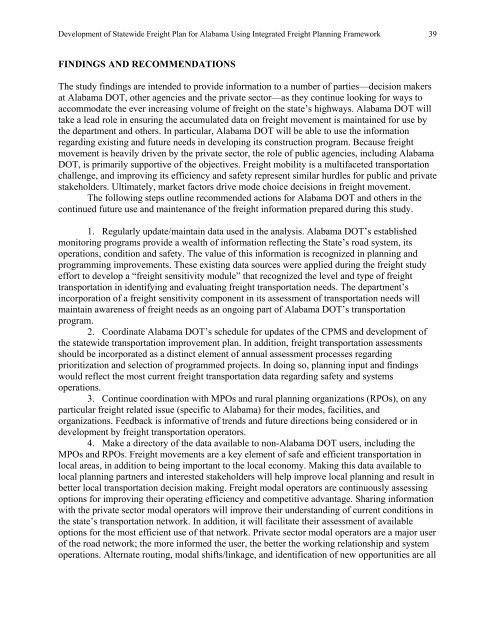E-C158 Cover1 - Center for Transportation Analysis - Oak Ridge ...
E-C158 Cover1 - Center for Transportation Analysis - Oak Ridge ...
E-C158 Cover1 - Center for Transportation Analysis - Oak Ridge ...
You also want an ePaper? Increase the reach of your titles
YUMPU automatically turns print PDFs into web optimized ePapers that Google loves.
Development of Statewide Freight Plan <strong>for</strong> Alabama Using Integrated Freight Planning Framework 39<br />
FINDINGS AND RECOMMENDATIONS<br />
The study findings are intended to provide in<strong>for</strong>mation to a number of parties—decision makers<br />
at Alabama DOT, other agencies and the private sector—as they continue looking <strong>for</strong> ways to<br />
accommodate the ever increasing volume of freight on the state’s highways. Alabama DOT will<br />
take a lead role in ensuring the accumulated data on freight movement is maintained <strong>for</strong> use by<br />
the department and others. In particular, Alabama DOT will be able to use the in<strong>for</strong>mation<br />
regarding existing and future needs in developing its construction program. Because freight<br />
movement is heavily driven by the private sector, the role of public agencies, including Alabama<br />
DOT, is primarily supportive of the objectives. Freight mobility is a multifaceted transportation<br />
challenge, and improving its efficiency and safety represent similar hurdles <strong>for</strong> public and private<br />
stakeholders. Ultimately, market factors drive mode choice decisions in freight movement.<br />
The following steps outline recommended actions <strong>for</strong> Alabama DOT and others in the<br />
continued future use and maintenance of the freight in<strong>for</strong>mation prepared during this study.<br />
1. Regularly update/maintain data used in the analysis. Alabama DOT’s established<br />
monitoring programs provide a wealth of in<strong>for</strong>mation reflecting the State’s road system, its<br />
operations, condition and safety. The value of this in<strong>for</strong>mation is recognized in planning and<br />
programming improvements. These existing data sources were applied during the freight study<br />
ef<strong>for</strong>t to develop a “freight sensitivity module” that recognized the level and type of freight<br />
transportation in identifying and evaluating freight transportation needs. The department’s<br />
incorporation of a freight sensitivity component in its assessment of transportation needs will<br />
maintain awareness of freight needs as an ongoing part of Alabama DOT’s transportation<br />
program.<br />
2. Coordinate Alabama DOT’s schedule <strong>for</strong> updates of the CPMS and development of<br />
the statewide transportation improvement plan. In addition, freight transportation assessments<br />
should be incorporated as a distinct element of annual assessment processes regarding<br />
prioritization and selection of programmed projects. In doing so, planning input and findings<br />
would reflect the most current freight transportation data regarding safety and systems<br />
operations.<br />
3. Continue coordination with MPOs and rural planning organizations (RPOs), on any<br />
particular freight related issue (specific to Alabama) <strong>for</strong> their modes, facilities, and<br />
organizations. Feedback is in<strong>for</strong>mative of trends and future directions being considered or in<br />
development by freight transportation operators.<br />
4. Make a directory of the data available to non-Alabama DOT users, including the<br />
MPOs and RPOs. Freight movements are a key element of safe and efficient transportation in<br />
local areas, in addition to being important to the local economy. Making this data available to<br />
local planning partners and interested stakeholders will help improve local planning and result in<br />
better local transportation decision making. Freight modal operators are continuously assessing<br />
options <strong>for</strong> improving their operating efficiency and competitive advantage. Sharing in<strong>for</strong>mation<br />
with the private sector modal operators will improve their understanding of current conditions in<br />
the state’s transportation network. In addition, it will facilitate their assessment of available<br />
options <strong>for</strong> the most efficient use of that network. Private sector modal operators are a major user<br />
of the road network; the more in<strong>for</strong>med the user, the better the working relationship and system<br />
operations. Alternate routing, modal shifts/linkage, and identification of new opportunities are all

















